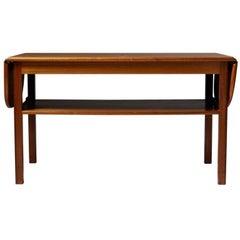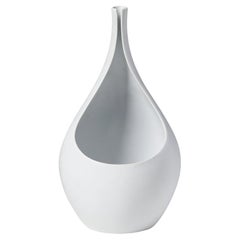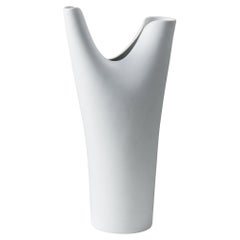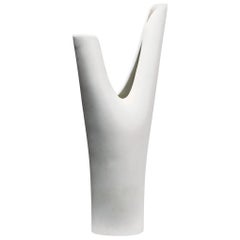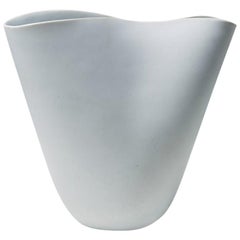Modernity Furniture
to
526
503
22
1
243
151
33
1
1
4
499
23
20
393
84
2
1
11
36
35
136
76
35
23
17
204
126
105
98
81
509
449
351
96
44
526
526
526
22
20
16
15
13
Occasional Table Designed by Josef Frank for Svenskt Tenn, Sweden, 1950s
By Josef Frank
Located in Stockholm, SE
Occasional table designed by Josef Frank for Svenskt Tenn,
Sweden, 1950s.
Mahogany.
Measurements:
H: 60 cm/ 23 1/2''
Length when extened: 104 cm/ 3' 5''
D: 54 cm/ 21 1/2''
Jose...
Category
Vintage 1950s Swedish Scandinavian Modern Side Tables
Materials
Mahogany
Painting by Sven Hansson, Sweden, 1993
By Sven Hansson
Located in Stockholm, SE
Painting by Sven Hansson,
Sweden. 1993.
Gouache on paper.
Signed.
Measurements:
H: 73 cm / 2' 9 3/4"
W: 69.5 cm / 2' 3 1/2"
D: 6 cm / 2 1/2".
Working in a purely geometric, non-f...
Category
Mid-20th Century Swedish Mid-Century Modern Paintings
Materials
Wood, Paint, Paper
Vase ‘Pungo’ designed by Stig Lindberg for Gustavsberg, Stoneware, Sweden, 1950s
By Stig Lindberg
Located in Stockholm, SE
Vase ‘Pungo’ designed by Stig Lindberg for Gustavsberg,
Sweden, 1950s.
Stoneware.
Stamped.
Measurements:
H: 24 cm / 9 1/2"
W: 13 cm / 5”
D: 11 cm / 4 1/4".
Stig Lindberg’s “Pungo” vases...
Category
Mid-20th Century Swedish Mid-Century Modern Vases
Materials
Ceramic, Stoneware
Vase “Veckla” Designed by Stig Lindberg for Gustavsberg, Sweden, 1940s
By Stig Lindberg
Located in Stockholm, SE
Vase “Veckla” designed by Stig Lindberg for Gustavsberg,
Sweden, 1940s.
Stoneware.
Stamped.
Measurements:
H: 30 cm / 11 3/4"
W: 16 cm / 6 1/3".
Stig Lindberg’s “Veckla...
Category
Vintage 1940s Swedish Mid-Century Modern Ceramics
Materials
Ceramic
Vase “Veckla” Designed by Stig Lindberg for Gustavsberg, Sweden, 1940s
By Stig Lindberg
Located in Stockholm, SE
Vase “Veckla” designed by Stig Lindberg for Gustavsberg,
Sweden, 1940s.
Ceramic.
Measurements:
H: 36 cm/ 1' 4"
D :17 cm/ 6 3/4".
Stig Lindberg’s “Veckla...
Category
Vintage 1940s Swedish Scandinavian Modern Vases
Materials
Ceramic
Vase “Veckla” Designed by Stig Lindberg for Gustavsberg, Sweden, 1940s
By Stig Lindberg
Located in Stockholm, SE
Vase “Veckla” designed by Stig Lindberg for Gustavsberg,
Sweden, 1940s.
Porcelain based stoneware.
Measurements:
H: 19 cm/ 7 1/2''.
Stig Lindberg’s “Veckla...
Category
Vintage 1940s Swedish Scandinavian Modern Vases
Materials
Stoneware
Vase “Reptile” Designed by Stig Lindberg for Gustavsberg, Sweden, 1953
By Stig Lindberg
Located in Stockholm, SE
Ceramic.
Measurements:
H: 22 cm/ 8 2/3"
W: 6.5 cm/ 2 1/2".
Stig Lindberg’s “Reptil” vases belong to a series produced from the 1950s onward. Li...
Category
Vintage 1950s Swedish Scandinavian Modern Ceramics
Materials
Ceramic
1950s Swedish Flat-Weave Rug – Handwoven Wool with Abstract Red Pattern
Located in Stockholm, SE
Kilim Technique.
Measurements
L: 336 cm / 11' 1"
W: 167 cm / 5' 5".
Category
Mid-20th Century Swedish Mid-Century Modern Russian and Scandinavian Rugs
Materials
Wool
Vase, Tulip Designed by Nils Landberg for Orrefors, Sweden, 1957
By Nils Landberg
Located in Stockholm, SE
Vase, tulip designed by Nils Landberg for Orrefors,
Sweden, 1957.
Glass.
Measurements
H: 44.5 cm/ 1' 6".
Category
Vintage 1950s Swedish Scandinavian Modern Vases
Materials
Glass
Set of Six Plant Trays Attributed to Paavo Tynell, Finland, 1950s
By Paavo Tynell
Located in Stockholm, SE
Copper and brass.
Measures:
L: 227 cm/ 7' 5 3/4"
W: 21 cm/ 8 1/4"
Provenance: The member's club at the Myllykoski paper mill, Finland. Paavo Tynell's office was responsible for th...
Category
Vintage 1950s Finnish Scandinavian Modern Planters and Jardinieres
Materials
Brass, Copper
Occasional Table PK61 Designed by Poul Kjaerholm for E. Kold Christensen
By Poul Kjærholm
Located in Stockholm, SE
Occasional table PK61 designed by Poul Kjaerholm for E. Kold Christensen,
Denmark, 1956.
Steel and Porsgrunn marble with fossils.
H: 33 cm/ 13"
L: 85 cm/ 33 1/2"
W: 85 cm/ 33 1/2"
Category
Vintage 1950s Danish Scandinavian Modern Coffee and Cocktail Tables
Materials
Marble
Ceiling Lamp ‘Beehive’ Model A332 Designed by Alvar Aalto for Valaistustyo
By Alvar Aalto
Located in Stockholm, SE
Ceiling lamp ‘Beehive’ model A332 designed by Alvar Aalto for Valaistustyo,
Finland. 1953.
Painted aluminium and polished brass.
Early six tier version.
Engraved ‘A332 Valaistusty...
Category
Mid-20th Century Finnish Mid-Century Modern Chandeliers and Pendants
Materials
Aluminum, Brass
Floor Lamp Designed by Alvar Aalto for Valaistustyö, Finland, 1950s
By Alvar Aalto
Located in Stockholm, SE
Cast iron, brass, lacquered metal and leather.
Rare model.
Alvar Aalto was a Finnish architect and designer. His work includes architecture, furniture, lighting, and glassware,...
Category
Vintage 1950s Finnish Scandinavian Modern Floor Lamps
Materials
Metal, Iron
Bedside Table Model ‘914’ Designed by Josef Frank for Svenskt Tenn, Sweden
By Josef Frank
Located in Stockholm, SE
Bedside table model 914 designed by Josef Frank for Svenskt Tenn,
Sweden, 1950s.
Mahogany veneer and brass handle.
Josef Frank’s elegant bedside table model 914 with sophisticated ...
Category
Mid-20th Century Swedish Mid-Century Modern Side Tables
Materials
Brass
Set of Six Dining Chairs Model 526 Designed by Josef Frank for Svenskt Tenn
By Josef Frank
Located in Stockholm, SE
Set of six dining chairs model 526 designed by Josef Frank for Svenskt Tenn,
Sweden, 1934.
Mahogany and rattan with seats upholstered in Frank’s "Anakreon" fabric.
Marked "BODAFORS...
Category
Vintage 1930s Swedish Mid-Century Modern Dining Room Chairs
Materials
Upholstery, Rattan, Mahogany
Floor Lamp Model 2564 Designed by Josef Frank for Svenskt Tenn, Sweden, 1950s
By Josef Frank
Located in Stockholm, SE
Floor lamp model 2564 designed by Josef Frank for Svenskt Tenn,
Sweden, 1950s.
White lacquered brass and Lacquered Paper.
Stamped.
This elegant brass floor lamp is adjustable in h...
Category
Mid-20th Century Swedish Mid-Century Modern Floor Lamps
Materials
Brass
Occasional Table Model 2168 Designed by Josef Frank for Svenskt Tenn
By Josef Frank
Located in Stockholm, SE
Occasional table model 2168 designed by Josef Frank for Svenskt Tenn,
Sweden. 1950s.
Walnut and marble.
Josef Frank’s occasional table “model 2168” is one of his rarer models. Its beautifully carved, turned legs...
Category
Mid-20th Century Swedish Mid-Century Modern Tables
Materials
Marble
Table Lamp Model 2434 Designed by Josef Frank for Svenskt Tenn, Sweden, 1939
By Josef Frank
Located in Stockholm, SE
Table lamp model 2434 designed by Josef Frank for Svenskt Tenn,
Sweden, 1939.
Polished and lacquered brass with fabric shade.
Measures:
H: 58 cm
W: 50 cm
Josef Frank was a true E...
Category
Mid-20th Century Swedish Mid-Century Modern Table Lamps
Materials
Brass
Dining Table Model 1197 Designed by Josef Frank for Svenskt Tenn, Sweden, 1940s
By Josef Frank
Located in Stockholm, SE
Dining table model 1197 designed by Josef Frank for Svenskt Tenn,
Sweden, 1940s.
Mahogany.
This simple yet elegant dining table is an excellent example of how Josef Frank combined...
Category
Mid-20th Century Swedish Mid-Century Modern Dining Room Tables
Materials
Mahogany
Walnut and Brass Serving Trolley Model 756 by Josef Frank for Svenskt Tenn 1940s
By Josef Frank
Located in Stockholm, SE
Serving trolley model 756 designed by Josef Frank for Svenskt Tenn,
Sweden, 1940s.
Veneered walnut and brass.
H: 65 cm
W: 53 cm
Width when fully extended: 89 cm
D: 80 cm
Josef Fr...
Category
Mid-20th Century Swedish Mid-Century Modern Carts and Bar Carts
Materials
Brass
Set of Six Chairs Model 2025 Designed by Josef Frank for Svenskt Tenn
By Josef Frank
Located in Stockholm, SE
Set of six chairs model 2025 designed by Josef Frank for Svenskt Tenn,
Sweden, 1950s.
Lacquered wood frame and a fabric upholstered seat.
Marked.
Josef Frank designed this chair i...
Category
Mid-20th Century Swedish Mid-Century Modern Chairs
Materials
Fabric, Upholstery, Wood, Bentwood, Lacquer
Sideboard Model 1148 Designed by Josef Frank for Svenskt Tenn, Sweden, 1950s
By Josef Frank
Located in Stockholm, SE
Sideboard model 1148 designed by Josef Frank for Svenskt Tenn,
Sweden, 1950s.
Walnut and alder root veneer.
This sideboard model 1148 with two clever extension flaps was designed b...
Category
Mid-20th Century Swedish Mid-Century Modern Sideboards
Materials
Walnut
Flat Weave Rug Designed by Greta Skogster-Lehtinen, Sweden, 1930s
By Greta Skogster-Lehtinen 1
Located in Stockholm, SE
Flat Weave Rug designed by Greta Skogster-Lehtinen,
Sweden, 1930s.
Fabric.
Measures:
L: 308 cm
W: 220 cm
Category
Mid-20th Century Swedish Mid-Century Modern Russian and Scandinavian Rugs
Materials
Fabric
Vintage Scandinavian Bar Cart – Swedish Teak Serving Trolley, 1950s
Located in Stockholm, SE
Serving trolley, anonymous, Sweden. 1950s.
Teak.
Rotating top.
Dimensions:
L: 68.5 cm/ 2' 3"
W (closed): 34 cm/ 1' 1/3"
W (open): 70 cm/ 2' 3 1/2"
H: 58.5 cm/ 1' 11"
Category
Vintage 1950s Swedish Mid-Century Modern Sideboards
Materials
Teak
Stool Designed by Ejner Larsen and Aksel Bender Madsen for Willy Beck
By Ejner Larsen and Aksel Bender Madsen
Located in Stockholm, SE
Denmark, 1950’s.
Teak and leather.
Stamped.
Measures:
H: 53 cm / 20 ¾’’
W: 54 cm / 21 ¼’’
D: 37 cm / 14 ½’’.
Category
Mid-20th Century Danish Mid-Century Modern Stools
Materials
Leather, Teak
Marble Top chest of drawers with brass detailing
Located in Stockholm, SE
Cabinet, anonymous,
Sweden, 1940s.
Mahogany, beech, marble and brass.
Dimensions:
H: 70 cm / 2' 3 1/2''
W: 71 cm / 2' 4''
D: 42 cm / 16 1/2''
Category
Vintage 1940s Swedish Mid-Century Modern Cabinets
Materials
Marble, Brass
Glass Bowl Designed by Simon Gate for Orrefors, Signed, Sweden, 1930
By Simon Gate
Located in Stockholm, SE
Bowl designed by Simon Gate for Orrefors,
Sweden, 1930.
Glass.
Signed.
Dimensions:
H: 15 cm / 6''
Diameter: 28 cm / 11''
Category
Vintage 1930s Swedish Mid-Century Modern Decorative Bowls
Materials
Glass
Rug Designed by Margareta Åkerberg for Gammelstads Mattor, Sweden
By Margareta Åkerberg
Located in Stockholm, SE
Rug designed by Margareta Åkerberg for Gammelstads Mattor, Sweden, 1950s.
Handwoven pure wool.
Kelim technique.
L: 245 cm/ 8'
W: 170 cm/ 5' 7''
Category
Vintage 1950s Swedish Scandinavian Modern Russian and Scandinavian Rugs
Materials
Wool
Set of three chairs ‘The Red Chairs’ model 3949 designed by Kaare Klint, Denmark
By Kaare Klint
Located in Stockholm, SE
Set of three chairs ‘The Red Chairs’ model 3949 designed by Kaare Klint for Rud. Rasmussen Fabrik,
Denmark, 1928.
Cuban mahogany, Niger leather, upholstery and brass nails.
Marked.
Our set of three ‘The Red Chairs’ model 3949 designed by Kaare Klint – they are known as ‘the small Red Chairs...
Category
Mid-20th Century Danish Mid-Century Modern Chairs
Materials
Brass
Vase 'Surrea' by Wilhelm Kåge for Gustavsberg, Stoneware, Sweden, circa 1940
By Wilhelm Kage
Located in Stockholm, SE
Vase ‘Surrea’ by Wilhelm Kåge for Gustavsberg,
Sweden, 1940.
Carrara-glazed stoneware.
Stamped "GUSTAVSBERG KÅGE".
Measurements:
H: 32.5 cm/ 12 3/4...
Category
Vintage 1940s Swedish Mid-Century Modern Vases
Materials
Stoneware
Swedish Grace Sofa Designed by Carl Malmsten, Mahogany Frame, Sweden, 1929
By Carl Malmsten
Located in Stockholm, SE
Swedish Grace sofa designed by Carl Malmsten, Sweden. 1929.
Mahogany frame with exotic wood inlay. Fabric upholstery.
Provenance: Commissioned by ...
Category
Vintage 1920s Swedish Mid-Century Modern Sofas
Materials
Fabric, Mahogany
Mid-Century Danish Cabinet – 1950s Pine Design with Drawers and File Slots
Located in Stockholm, SE
Cabinet, anonymous,
Denmark, 1950s.
Oregon pine.
This charming piece is an exquisite example of Danish cabinetmaking. The visible corner joints and the stretcher’s through mortise...
Category
Vintage 1950s Danish Mid-Century Modern Cabinets
Materials
Pine
Rug Designed by Greta Skogster-Lehtinen for Aaltosen Mattokutomo, Finland, 1930s
By Greta Skogster-Lehtinen 1
Located in Stockholm, SE
Rug designed by Greta Skogster-Lehtinen for Aaltosen Mattokutomo,
Finland, 1930s.
Flat weave.
Crafted in Finland by Aaltosen Mattokutomo in the 1930’s, Greta Skogster-Lehtinen desi...
Category
Mid-20th Century Finnish Mid-Century Modern Russian and Scandinavian Rugs
Materials
Wool, Linen
1880s Rustic Copper Cauldron – Handcrafted Swedish Pot with Handles
Located in Stockholm, SE
Cauldron, anonymous,
Sweden. 1880s.
Copper cauldron.
Dimensions:
H: 22 cm
D: 59 cm
Category
Antique 1880s Swedish Folk Art Decorative Bowls
Materials
Copper
Stool Designed by Erik Höglund for Kopparfly, Beech and Leather, Sweden, 1950s
By Erik Höglund
Located in Stockholm, SE
Stool designed by Erik Höglund for Kopparfly,
Sweden. 1950s.
Beech, hemp webbing and leather.
Dimensions:
W: 60 cm/ 23 1/2"
D: 29 cm/ 11 1/2"
Category
Vintage 1950s Swedish Mid-Century Modern Stools
Materials
Leather, Hemp, Beech
Sculpture 'Sleeping Boxer' Designed by Thure Öberg for Arabia, Finland, 1910
By Thure Öberg
Located in Stockholm, SE
Sculpture 'Sleeping Boxer' designed by Thure Öberg for Arabia,
Finland, 1910.
Porcelain.
Dimensions:
H: 10 cm
W: 14 cm
L: 36.5 cm.
Category
Early 20th Century Finnish Mid-Century Modern Porcelain
Materials
Porcelain
Large Porcelain Dog Sculpture in form of a Bloodhound 1950s
Located in Stockholm, SE
Sculpture, anonymous,
Italy 1950s.
Glazed clay.
Representing a bloodhound.
Measurements:
H: 86 cm/ 2' 7/8"
W: 50 cm/ 1' 7 3/4"
D: 40 cm/ 1' 3 7/8"
Category
Vintage 1950s Italian Mid-Century Modern Animal Sculptures
Materials
Clay
Tapestry 'Forest Fragments' by Elsa Agélii, Silk and Mixed Media, 1988, Sweden
By Elsa Agélii
Located in Stockholm, SE
Tapestry “Forest Fragments” by Elsa Agélii,
Sweden, 1988.
Silk and mixed media.
Dimensions:
H: 155 cm/ 5' 1''
W: 135 cm/ 4' 5''
Category
Vintage 1980s Swedish Scandinavian Modern Tapestries
Materials
Textile, Silk
Tapestry ‘Vävnad’ Designed by Ingemar Callenberg for Gammelstads Handväveri AB
By Ingemar Callenberg
Located in Stockholm, SE
Tapestry ‘Vävnad’ designed by Ingemar Callenberg for Gammelstads Handväveri AB,
Sweden, 1950s.
Wool.
Measures: L: 118 cm
W: 49 cm.
Category
Mid-20th Century Swedish Mid-Century Modern Tapestries
Materials
Wool
Rectangular Blue Swedish Rug by Gammelstads Handväveri, 1950s
Located in Stockholm, SE
Rug, anonymous for Gammelstads Handväveri,
Sweden, 1950s.
Wool.
Measures : L: 313 cm
Length including the tassels: 322 cm
W: 193 cm.
Category
Mid-20th Century Swedish Mid-Century Modern Russian and Scandinavian Rugs
Materials
Wool
'The Propeller Stool’ Model 8783 Designed by Kaare Klint, Denmark 1930s
By Kaare Klint
Located in Stockholm, SE
‘The Propeller Stool’ model 8783 designed by Kaare Klint for Rud. Rasmussens Cabinetmakers,
Denmark, 1930.
Canvas and ash.
Signed.
Kaare Klint was the father of Scandinavian moder...
Category
Mid-20th Century Danish Mid-Century Modern Stools
Materials
Canvas, Ash
Folding 'Screen 100' Designed by Alvar Aalto for Artek, Finland, 1936
By Alvar Aalto
Located in Stockholm, SE
Folding 'Screen 100' designed by Alvar Aalto for Artek,
Finland. 1936.
Pine.
Alvar Aalto’s 'Screen 100' designed in 1936 is a sculptural room divider made entirely of individual...
Category
Mid-20th Century Finnish Mid-Century Modern Screens and Room Dividers
Materials
Pine
Unique Set of three Swedish Sculptures by Jan Johansson, Glass, Limestone, 1970s
By Jan Johansson
Located in Stockholm, SE
Sculpture, designed by Jan Johansson, Sweden, 1970s.
Unique.
Different colored glass blocks on limestone pedestals.
Heights including the pedestals:
106 cm/ 41 3/4''
82 cm/ 32 1/...
Category
Vintage 1970s Swedish Scandinavian Modern Sculptures
Materials
Limestone
1897 Swedish Carved Armchair – Designed for A. Lagerberg with Painted Folk Motif
Located in Stockholm, SE
Painted pine.
Presented at the Stockholm exhibition of 1897.
Measures: H 108 cm/ 3'7”
W 60 cm/ 23 1/2"
D 56 cm/ 22”
SH 42 cm/ 16 1/2".
Category
Antique 1890s Swedish Scandinavian Modern Armchairs
Materials
Pine
Floor Lamp ‘Aj Royal’ Designed by Arne Jacobsen for Louis Poulsen, Denmark
By Arne Jacobsen
Located in Stockholm, SE
Floor lamp ‘AJ Royal’ designed by Arne Jacobsen for Louis Poulsen,
Denmark, 1950s.
Textile and metal.
Measures: H: 181.5 cm
Height of the shade: 60.5 cm
Width of the shade: ...
Category
Mid-20th Century Danish Mid-Century Modern Floor Lamps
Materials
Metal
Vintage 1900s Swedish Textile Art – Handwoven Tapestry with Figurative Motif
Located in Stockholm, SE
Tapestry, anonymous,
Sweden, early 1900s.
Hand-woven wool and linen.
Provenance: From a private Swedish collection.
Measurements:
L: 152 cm / 4' 11 3/4''
W: 138.5 cm / 4' 6 1/2''
Category
Early 20th Century Swedish Mid-Century Modern Tapestries
Materials
Wool, Linen
Set of Twelve Dining Chairs ‘Darby’ Designed by Torbjörn Afdal for Bruksbo
By Torbjørn Afdal
Located in Stockholm, SE
Set of twelve dining chairs ‘Darby’ designed by Torbjörn Afdal for Bruksbo.
Norway, 1960s.
Rosewood and leather.
This dining chair model 'Darby' is simple yet elegant with a s...
Category
Mid-20th Century Norwegian Mid-Century Modern Dining Room Chairs
Materials
Leather, Rosewood
Occasional Table ‘The Egyptian Table’ Designed by Mogens Lassen for A.J. Iversen
By Mogens Lassen
Located in Stockholm, SE
Occasional table ‘The Egyptian Table’ designed by Mogens Lassen for A.J. Iversen,
Denmark, 1960s.
Mahogany, foldable frame and top with raised e...
Category
Mid-20th Century Danish Mid-Century Modern Coffee and Cocktail Tables
Materials
Brass
Shelf Designed by Alvar Andersson for Hyresgästernas Möbelaffär, Sweden, 1930s
By Alvar Andersson
Located in Stockholm, SE
Shelf designed by Alvar Andersson for Hyresgästernas Möbelaffär,
Sweden, 1930s.
Lacquered wood with metal inlays.
Measures: H: 115 cm
W: 80.5 cm
D: 27 cm
Category
Mid-20th Century Swedish Mid-Century Modern Shelves
Materials
Metal
Side Table Designed by Severin Hansen Jr. for Haslev Möbelsnedkeri, Denmark
By Severin Hansen Jr.
Located in Stockholm, SE
Side table designed by Severin Hansen Jr. for Haslev Möbelsnedkeri.
Denmark, 1950s.
Rosewood.
Stamped.
Measures: H: 50 cm
W: 50 cm
D: 35 cm.
Category
Mid-20th Century Danish Mid-Century Modern Side Tables
Materials
Rosewood
Rug ‘Dukater’ Designed by Märta Måås-fjetterström, Sweden, 1924
By Märta Måås-Fjetterström
Located in Stockholm, SE
Rug ‘Dukater’ designed by Märta Måås-Fjetterström,
Sweden, 1924.
Wool.
Signed MMF.
Measurements:
L: 347 cm
Length including the tassels: 365 cm
W: 265 cm.
Märta Måås-Fjetterstr...
Category
Mid-20th Century Swedish Mid-Century Modern Russian and Scandinavian Rugs
Materials
Wool
Wall Hanging Sculpture by Britt-Ingrid Persson, Sweden, 1960s
By Britt-Ingrid Persson
Located in Stockholm, SE
Wall hanging sculpture by Britt-Ingrid Persson,
Sweden, 1960s.
Earthenware.
Signed.
Measures: H: 24 cm
W: 19.5 cm
D: 19.5 cm.
Category
Mid-20th Century Swedish Mid-Century Modern Ceramics
Materials
Earthenware
Sofa Bo64 Designed by Finn Juhl for Bovirke, Denmark, 1940s
By Finn Juhl
Located in Stockholm, SE
Sofa BO64 designed by Finn Juhl for Bovirke,
Denmark, 1940s.
Savak wool upholstery and stained wooden legs.
Provenance: Acquired by current owner at Bovir...
Category
Mid-20th Century Danish Mid-Century Modern Sofas
Materials
Wool, Wood
Easy chair designed by Alvar Andersson for Ferdinand Lundquist & Co
By Alvar Andersson
Located in Stockholm, SE
Easy chair designed by Alvar Andersson for Ferdinand Lundquist & Co,
Sweden, 1940s.
Textile and birch.
Marked.
H: 89 cm / 2' 11''
W: 71 cm / 2' 4''
D: 69 cm / 2' 3 1/4''
SH: 43 cm...
Category
Mid-20th Century Swedish Mid-Century Modern Chairs
Materials
Textile, Birch
1950s Swedish Metal Tea Trolley for Svenskt Tenn – Mid-Century Design
Located in Stockholm, SE
Tea trolley, anonymous, for Svenskt Tenn,
Sweden, 1950s.
Metal.
Dimensions:
H: 63 cm / 2 3/4''
W: 76 cm / 2' 6''
D: 43 cm / 17''.
Category
Mid-20th Century Swedish Mid-Century Modern Tables
Materials
Metal
Pewter Jar with Lid Designed by Estrid Ericson for Svenskt Tenn, Sweden, 1930
By Estrid Ericson
Located in Stockholm, SE
Pewter jar with lid designed by Estrid Ericson for Svenskt Tenn,
Sweden, 1930.
Pewter.
Stamped.
H: 21.5 cm / 8 1/2''
D: 15 cm / 6''
Provenance: Actor Anders de Wahl (18...
Category
Mid-20th Century Swedish Mid-Century Modern Jars
Materials
Pewter
Mirror Designed by Estrid Ericson for Svenskt Tenn, Sweden, 1930
By Estrid Ericson
Located in Stockholm, SE
Mirror designed by Estrid Ericson for Svenskt Tenn,
Sweden, 1930.
Pewter and mirror.
Measures: H: 62.5 cm / 2' 1/2''
W: 41 cm / 16''
D: 2 cm / 3/4''.
Category
Mid-20th Century Swedish Mid-Century Modern Mirrors
Materials
Pewter
Urn Designed by Gunnar Nylund for Rörstrand, Sweden, 1936
By Gunnar Nylund
Located in Stockholm, SE
Urn designed by Gunnar Nylund for Rörstrand,
Sweden, 1936.
Stoneware.
Signed.
Dimensions:
H: 78.5 cm / 2' 7''
D: 53 cm / 21''
Exhibitions: In Paris 1937 at the World's Fair, Gunn...
Category
Mid-20th Century Swedish Mid-Century Modern Ceramics
Materials
Stoneware
Framed Drawing ‘Rider in a Spring Landscape’ by Vicke Lindstrand, Sweden, 1950s
By Vicke Lindstrand
Located in Stockholm, SE
Framed drawing ‘Rider in a Spring Landscape’ by Vicke Lindstrand,
Sweden, 1950s.
Ink on paper.
Signed.
Measures: H: 39.5 cm / 15 1/2''
W: 34 cm / 13 1/4''.
Category
Mid-20th Century Swedish Mid-Century Modern Drawings
Materials
Paper
Framed Drawing ‘Couple in a Spring Landscape’ by Vicke Lindstrand, Sweden, 1950s
By Vicke Lindstrand
Located in Stockholm, SE
Framed drawing ‘Couple in a Spring Landscape’ by Vicke Lindstrand,
Sweden, 1950s.
Ink on paper.
Measures: H: 38 cm / 15''
W: 34 cm / 13 1/4''.
Category
Mid-20th Century Swedish Mid-Century Modern Drawings
Materials
Paper
